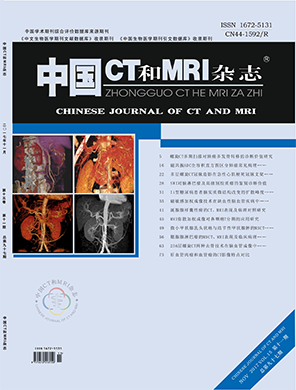摘要
目的 分析比较自动去骨技术与 减影去骨技术在256层螺旋CT脑血管成像 中图像质量的差异。方法 回顾性分析47 例脑血管疾病(如钙化、动脉瘤)患者资 料,所有脑血管成像序列根据不同的去 骨后处理方法分为对照组和观察组,对 照组采用自动去骨成像技术,观察组采 用减影去骨成像技术,对去骨后的CTA 图像进行质量评估。比较两种去骨技术 的成功率(是否影响诊断)。2名观察者 对各组图像质量主观评分的一致性采用 Kappa检验,采用独立样本t检验比较两 组图像主观评分。结果 对照组与观察组 组去骨的成功率分别为70.21%(33/47)和 93.62%(44/47)。两位观察者的相关系数 为0.914,观察组图像质量明显高于对照 组图像,两组图像质量有统计学差异(评 分为(2.76±0.84) vs (3.68±0.73), t=-5.978,P<0.05)。结论 在颅内虹吸段 血管有钙化情况下,减影去骨技术较自动 去骨技术可显著提高诊断的准确性,在临 床怀疑小动脉瘤时,采用减影去骨技术, 可降低漏诊率。
Objective To compare the difference of automatic boneless and subtraction boneless technologyin cerebral vascular image of 256-slice spiral CT image quality. Methods Retrospective analysis cerebrovascular disease(such as calcification, aneurysm) clinical data of 47 patients. According to the different way of post-processing method, all cerebral images divided into control group and observationgroup.control group underwent automatic boneless technology, the observation group received subtraction boneless technology, difference comparison of image quality between two groups of cerebral angiography. To compare the successive rates of the two methods. Two observers of the subjective image quality score using Kappa consistency test, image subjective ratings Comparison between two groups was done with independent sample T-test. Results The control group and observation group boneless success rate was 70.21% (33/47) and 93.62% (44/47). The correlation coefficient of two observers was 0.914,Image quality of observation group was significantly higher than the control group in the image, the image quality was statistically difference between the two groups (2.76±0.84) vs (3.68±0.73), t=5.978, P<0.05). Conclusion In intracranial vascular siphon segment with calcification, subtraction boneless technology can significantly improve the accuracy of diagnosis, the clinical suspicion small aneurysms or assess artery stenosis degree, boneless technology, adopt subtraction angiography can reduce missed diagnosis and reduce the narrow exaggerated effect. Clinically suspected small aneurysms subtraction boneless technology can reduce missed diagnosis and reduce the narrow exaggerated effect
【关键词】脑卒中;CTA;一键去骨技 术;蒙片减影技术
【中图分类号】R743
【文献标识码】A
【DOI】10.3969/j.issn.1672- 5131.2017.11.019
前言
随着我国老龄化及生活水平的提高,脑血管病已成为我国死 亡原因排名第一的疾病。建议40岁以上人群应定期体检,高危个 体应进行颅内外血管评估,发现异常应积极干预[1]。在脑血管疾病 的早期诊断或预防性治疗中,目前常用磁共振血管造影(magnetic resonance angiography:MRA)、CT血管造影(computed tomographic angiography:CTA)和数字减影血管造影(Digital Subtraction Angiography:DSA)等影像学检查来评估颅内动脉粥样硬化疾病,而在 狭窄程度的测定与侧支循环的评估方面DSA与CTA有更高的准确性[2-3]。 其中,CTA成像技术具有高空间分辨率、时间分辨率,可以三维显示脑 血管解剖结构的特点,是临床上诊断颅内血管疾病的一种快速、有效 的检查方法。头颅CTA的后处理方法较多,其中去骨后处理技术去除了 颅骨对血管的干扰,可明显提高血管疾病的准确性,但当设备或后处 理技术不同时,病灶检出的敏感性与特异性会有所差异[3-4]。在脑血管 疾病(如钙化、小动脉瘤)存在的情况下,如何减小干扰,提高脑血管 疾病的检出率,成为头颅CTA检查的研究重点。本文的目的就是分析比 较自动去骨技术与减影去骨技术在脑血管疾病(如钙化、小动脉瘤)CTA 成像中的差异。
中国CT和MRI杂志
第15卷, 第 11 期
2017年11月

相关文章